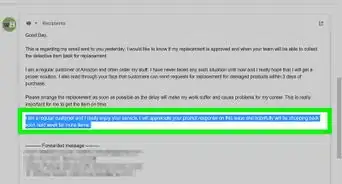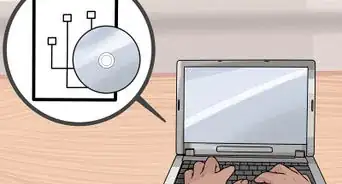This article was co-authored by Art Lewin. Art Lewin is an Entrepreneur based in Los Angeles, California. He specializes in business, sales, marketing, and real estate investing. Art is the CEO and Founder of four companies based in Los Angeles: Art Lewin Bespoke, Healthy Choice Labs, SFR Properties, and Professional Business Network (PBN). Art is known globally for his exclusive custom-made and ready-to-wear business wear designs. Some of his notable clients include royal family members, politicians, and Hollywood stars including Hugh Hefner, Sylvester Stallone, Johnny Carson, Steve Allen, and William Shatner.
There are 9 references cited in this article, which can be found at the bottom of the page.
This article has been viewed 180,490 times.
Anyone who's ever held a job working with customers knows how difficult it can be to stay calm and keep everybody satisfied day in and day out. Customer complaints, complex or unusual requests, and managers who only seem to be around when you're messing something up – it's a recipe for a meltdown if you aren't prepared. Read this guide to learn how to handle every customer with grace and confidence.
Steps
Developing Good Service Habits
-
1Take pride in your ability. Employers often talk about taking pride in your work, but a service worker's work isn't all that exciting, per se. Instead, take pride in your own ability to do that work. Start being impressed with how well you manage during each shift. There's no better way to encourage yourself to do even better than to let yourself believe that you're capable of doing better.
- In lower-level service jobs especially, you may not be treated as though you have much personal ability, but that's simply not the case. It takes poise, perseverance, and social skills to handle customers, even at a fast food drive-through window.
-
2Put your best foot forward. The best way to handle customers is to never give them a chance to dislike you. A big part of that is making a positive physical impression on them. Dress neatly, in clean clothes. Bathe regularly, and brush your teeth and use deodorant every day.[1] Walk with an easy stride, make eye contact, and speak in a loud, clear, relaxed voice. Your customers will feel as though they're in the hands of a professional right away, discouraging any urge to nitpick the rest of your performance.\[2]
- If you sweat a lot or have any other condition that might make you smell or look less than your best after a few hours on the clock, see if there's any way to bring some emergency hygiene supplies to work and pop out for five minutes partway through your shift to replenish.
Advertisement -
3Start with a smile. If you're really leaving your own worries, fears, annoyances, and insecurities at home each day, it's an easy next step to teach yourself to smile and be genuinely glad to greet every new customer. Don't be self-conscious – let your face open into the biggest, sunniest smile you've got every time you greet someone at work (even if it's over the phone, since a real smile comes through in your voice, too). You might be surprised just how much of a difference it makes in the way customers treat you.[3]
- Don't forget to smile at your coworkers and, yes, even your bosses. It costs nothing except a little self-consciousness, and it will reduce your workplace stress considerably if you can keep it up. Smiles are contagious.
- Pay attention the next time you go out shopping or visit a restaurant, and you'll see that some service workers always seem sullen and vaguely resentful. That's because they aren't focused enough on the work, and are too concerned with who's “okay” to interact with and who's “not okay.” Think about how unwelcome such people make you feel, and resolve not to make others feel that way at your own job.
-
4Leave your “self” at home. This is one of the most important skills a customer service worker can learn, as it's often what separates the happy workers from the miserable ones. In a nutshell, you aren't at work to demonstrate who you are. You're only at work to do a good job and get paid. The customers who interact with you at your job don't know what pet peeves you have, what your favorite food is, or what you think of the clothes they're wearing – and just as importantly, they don't care. They're talking to you because they need service. Always keep that in mind.
- If you're insecure or nervous about what people think of you, leaving your worries at home should help you to deal more confidently with customers. Focus on their needs and wants instead of their thoughts about you. They aren't a part of your personal life, so it's safe to disregard what they might think of you.
- If you're constantly frustrated by customers or find yourself silently judging them (even the nice ones), leaving that bad attitude at home will help you relax and do your job more efficiently. Remember, the customers are the lifeblood of the business, and therefore of your paycheck.
-
5Don't take things personally. Customers don't really have much invested in what they say about you; they're just reacting in the heat of the moment, for better or worse. Obviously, praise is preferable to criticism, but either way, the customer's opinions don't matter as much as their continued business does. Just let everything they say slide over you and disappear. Continue providing the best service you can to each customer, regardless of how they react.[4]
- Never take out a bad experience with one customer on the next customer you come into contact with. Compartmentalize the incident and see it for what it was – unpleasant, but isolated. Once you grasp that, it becomes easy to ignore. The only time a bad customer experience snowballs is when you take their bile and spread it around. By not taking your customers personally, you can be sure the buck stops with you.
- Be proud when you receive a compliment. However, don't take it as a cue to stop striving to provide even better service. The people who receive the most positive feedback from their customers are the people who never stop going the extra mile to make them feel happy and at ease.
-
6Take your customers seriously. Many a young or inexperienced service employee has gotten chewed out by a manager (or even fired) for scoffing at a bizarre or rude customer request. The fact is, you should always, always, always assume the customer is serious. Customers very rarely kid, and there's no way to know what's going through their minds as they speak to you. Be pleasant and earnest when you respond, no matter how their words sounded to you.[5]
- Remember, especially in brick-and-mortar service jobs, you'll sometimes run into customers with mental illness, developmental disabilities, or speech impediments. If you make a habit of always taking every customer request seriously, you won't put yourself in the awkward position of being rude to someone for something they actually couldn't help.
- Sometimes, customers are trying to have a joke at your expense. That's fine; it's no fun for you, but remember, it doesn't matter and won't make any difference in your life later. Keep in mind the steps you've read and stay separated from the experience. Don't take it personally.
- Very often, if you approach a “joke” request as though it's serious, you can make the joke fall flat and steal a bit of the rude customer's thunder without being rude at all. The customer was probably assuming you weren't dedicated enough to really “fall for it;” once he or she sees that you were actually ready to do whatever you could to satisfy the request, his or her opinion of you will change for the better.
-
7Be humble. A humble worker embodies all the qualities outlined above. She provides consistent service regardless of the customer or the customer's attitude, smiles and tries to get along with everyone who crosses her path, and doesn't let personal misgivings or rough transactions color her actions. A humble service employee also knows when to pass the torch to a manager. There are times when you can't satisfy a customer, or can't fill a special request. That's what managers are for. There's no shame in calling them to help.[6]
- Don't seem frustrated or angry when you have to bring a manager over to sort things out for your customers; instead, frame it to them as an extra step you're glad to take to make sure they're satisfied. Customers want to feel glad that you're working for their benefit, not guilty or upset because their request bothered you.[7]
- Once the transaction is finished, ask the manager (after the customer has gone) to explain what they did, and what you should do the next time a similar situation comes up. Sometimes you can learn new and useful information so you can provide a smoother customer experience next time.
-
8Don't rush customers. You should always be in a rush to help them, but they can take all the time they need. If a line or queue is building behind an exceptionally slow customer, see if you can get someone else to take a part of the line for you.
- If nobody else can help, continue to smile and be pleasant. The customers know it's not your fault that things are held up; they might not be so forgiving if you seem to be slowing things down even more by losing your cool and making mistakes.
Problem Customers and Customer Complaints
-
1Learn more than just the rules. Most service businesses have a clear set of rules for their workers. However, there's almost always a second, more flexible set of “rules” that govern the lengths to which you can bend or break the posted rules in order to keep a customer satisfied. Knowing these will help you go above and beyond the call of duty (which more often than not, calms customers down regardless of the eventual outcome) without getting in trouble.
- Most often, only management is allowed to make these exceptions, but ask and learn all you can to find any customer situation where you're also allowed to bend the rules. Sometimes, mollifying an irate customer is just a matter of showing them you'll make an exception in their case. Learn how to do it safely.
-
2Skip a beat. Sometimes, customers drop all pretense of politeness and say something rude or mean. Nine times out of ten, if you let it slide without even acknowledging that it was said, the customer will immediately feel guilty about crossing that line and become much more peaceful for the rest of the conversation.
- If you can directly respond to an insult as though you didn't even realize it was meant as an insult, that's even better. The customer will be on his or her best behavior for the rest of the transaction in most cases, because he or she has been given a free do-over on a needless insult and would like you to not figure out what the original intent of it was.
-
3Win them over with kindness. This doesn't mean being passive-aggressive; it means responding to irate customers the same way you'd respond to your favorite customers. Many customers who heckle you are only trying to get a rise out of you so they have even more to complain about. Don't give them the satisfaction. Just keep providing service with a smile and a can-do attitude, at least until the customer crosses the line and begins to actually abuse you verbally. (At that point, more drastic measures may be required.)[8]
- It's perfectly fine to gripe about customers, but do it well away from where other customers can hear you, and do it after they've left. If you don't have a good place to commiserate with your coworkers about a bad customer, you're better off just keeping it to yourself and venting at home.
-
4Talk to management. When there's a recurring problem customer, it's up to your store's management team to set a policy for dealing with him or her. Let them know there's a customer who's become a real problem for you and your fellow workers, and ask for advice on what to do about it. In some cases, the problem customer will be removed from the store; in many, the manager will assume the responsibility of catering to the customer.
-
5Know your limits. “The customer is always right” is a guideline for service, not a decree allowing customers to walk all over you. Doing everything you can reasonably do to make your customers happy is very different from enduring humiliation and abuse in the name of your job. While it's important to have a thick skin and not let most things upset you, once in a while, a customer will blatantly cross the line. At such times, you have the right to calmly ask them to stop, and explain how it makes you feel.
- Sadly, your freedom to put the kibosh on customer abuse varies somewhat from company to company. However, generally speaking, you're allowed to draw the line at being personally attacked, shamed or ridiculed in front of an audience, or physically assaulted.
- If the customer still won't stop attacking you, get help from your fellow employees. You always have the right to handle the customer with the assistance of a manager or coworker who's willing to assume the burden.
-
6Stand your ground. Very, very rarely, a customer may decide to spend his or her day ruining your day for no good reason, and you'll find yourself without a manager or helpful coworker in sight. At these times, you need to look out for yourself first.[9] Don't tempt the customer to lash out at you by showing your emotions, but don't stand for abuse, either. Tell the customer to wait while you get a manager; if they don't want a manager, tell them there's nothing more you can do for them, and that they need to leave. Look them in the eye and don't back down from what you're saying.
- Again, staying calm and collected is the most important thing in this situation. Don't raise your voice or say anything rude, and don't sob or cry. Don't even let yourself smile or frown.[10] Any sign of uncontrolled emotion will either make the customer even angrier, or spur them to continue abusing you.
- Don't ask them to leave, tell them they need to leave. You can explain yourself, but don't waver. If you're suffering an extraordinary amount of customer abuse and there's nobody around to help you deal with it, it's better to get written up than it is to let your spirit be crushed. A decent employer won't fire you for acting in your own best interests in such an extreme situation.
Fostering a Positive Coworker Environment
-
1Understand why coworkers are important to you. Having coworkers on your side confers a wealth of benefits. When you get along with your coworkers, you have people at your level who can empathize with your day-to-day experience, which helps keep your stress level down on the job. Coworkers who like you are also easier to ask favors of, and more likely to provide favors for you without being asked. Finally, coworkers can give you advance warning about management changes, upcoming reviews, and anything you're doing or not doing that might result in disciplinary action.
- Experienced customer service veterans often say that any customer service job is bearable, and can even be enjoyable, as long as you and your coworkers like each other. Feeling as though you're a valued part of the team drastically increases your job satisfaction.
-
2Treat coworkers similarly to customers. In particular, smile and say hello to every one of them, even if you don't like them or care about them, and even if they don't smile back. People are awash with insecurities, but nearly everybody appreciates a person who seems to like them enough to smile at them without trying to hide it.[11]
- You should also follow the rule of leaving your “self” at home when interacting with coworkers. Don't get emotional with them. Keep conversations light and inconsequential.
- Don't assume your coworkers agree with your opinions. Instead, ask them what they think of something, so you can respond with your opinion in a way that won't offend or alienate them.
-
3Be outgoing. Even if you aren't much for socializing, fake it at work. Once you've settled into your job, invite your fellow shift workers to come have coffee or a beer with you after ward – and keep doing it every week until people start to say yes. Agree to spend time at other people's functions, if they invite you. (If they don't, try not to sweat it – it's probably nothing personal against you.) Make conversation with coworkers whenever you share a break or have some down time.[12]
- There's no call to put pressure on people to spend more time with you. Sometimes, your coworkers won't be interested. That's fine – again, don't take it personally. Ease off the social invitations if someone keeps refusing them; reduce your small talk to a simple “hello” if someone seems intent on having a quiet break instead of chatting with you.
-
4Work hard. At the end of the day, the best way to endear yourself to your fellow workers is to be a good employee. Find things to do when there's downtime, to reduce the burden on your coworkers later. If you can, always be ready to go out of your way to assist your coworkers with whatever they need to get done. Don't wait to be asked; offer your help instead. Ask more experienced coworkers how they do things so well or so fast, and then take their advice to heart – everybody loves feeling respected for their practical skills and knowledge.[13]
-
5Don't gossip. There's no need to tell other people not to gossip (as it only upsets them), but don't do it yourself. In particular, when you feel the need to talk about someone else and they aren't around, speak as though they could walk over and hear you at any moment. Maintain neutrality when one person complains to you about someone else by saying things like “I don't know, I don't mind working with him/her.” You can sympathize with other people's problems, but don't make them your own.
- If you have interesting or useful information about a coworker that you want to share, that's fine as long as you leave judgments and negative emotions out of it. State what you know, and let others fill in their own emotional response.
-
6Communicate clearly. There's more to getting along with your coworkers than just being nice. You also need to be able to address issues calmly and clearly as soon as they arise. Your fellow employees already know you as someone who smiles at them and seems happy to speak with them; now let them know that you can't be walked across just because you're friendly. If a coworker is taking credit for your work, obstructing an important walkway, or otherwise disrupting the flow of your job, tell them immediately.
- Again, leave emotions out of the equation. Explain yourself clearly and coolly. For example, “I've seen you ring up a few of my customers without asking them who helped them, and it's costing me money. I always ask my customers who helped them, and I give commission credit to whoever they say. All I ask is that you do the same for me.”
- In some cases, you may not be comfortable speaking to a coworker about such matters. It's fine to go through managerial channels to resolve these situations. Just remember that if you feel safe doing so, speaking to your coworker directly will often be seen by that coworker as more upstanding and honest on your part, since you aren't alerting management to the issue before giving him or her a chance to resolve it.
Community Q&A
-
QuestionWhere should I draw the line when providing service for a customer?
 Community AnswerThe line is once you've done the best you can and there is nothing else you can do and nowhere else to go. If you can go the extra mile, do it, because that's what excellent customer service is about. Of course, never tolerate verbal abuse -- you're not a punching bag, after all.
Community AnswerThe line is once you've done the best you can and there is nothing else you can do and nowhere else to go. If you can go the extra mile, do it, because that's what excellent customer service is about. Of course, never tolerate verbal abuse -- you're not a punching bag, after all.
References
- ↑ http://www.health.gov.au/internet/publications/publishing.nsf/Content/ohp-enhealth-manual-atsi-cnt-l~ohp-enhealth-manual-atsi-cnt-l-ch3~ohp-enhealth-manual-atsi-cnt-l-ch3.7
- ↑ Art Lewin. Entrepreneur. Expert Interview. 11 June 2021.
- ↑ Art Lewin. Entrepreneur. Expert Interview. 11 June 2021.
- ↑ Art Lewin. Entrepreneur. Expert Interview. 11 June 2021.
- ↑ https://www.vendhq.com/blog/how-to-deal-with-difficult-customers/
- ↑ https://www.monster.com/career-advice/article/how-to-deal-with-difficult-customers
- ↑ https://www.monster.com/career-advice/article/how-to-deal-with-difficult-customers
- ↑ https://www.vendhq.com/blog/how-to-deal-with-difficult-customers/
- ↑ https://www.bigfin.com/blog/5-strategies-dealing-difficult-clients/
- ↑ https://smallbusinessbc.ca/article/ten-tips-dealing-customers/
- ↑ https://www.workitdaily.com/build-relationships-coworkers
- ↑ https://www.workitdaily.com/build-relationships-coworkers
- ↑ Art Lewin. Entrepreneur. Expert Interview. 11 June 2021.
- http://www.perfectapology.com/customer-apology-letter.html
About This Article
One way to handle customers is to let any mean or rude comments slide without responding to them, since they’re likely just reacting in the heat of the moment. For example, you can pretend you didn’t realize their comment was rude or mean and just continue on with the conversation. If the customer is still unhappy, do your best to treat them in the same way you’d treat a happy customer. For example, approach them with a smile if they look like they need assistance and carry out their requests with a can-do attitude. For more tips, like how to stand your ground when your manager isn’t around, keep reading!

















































































